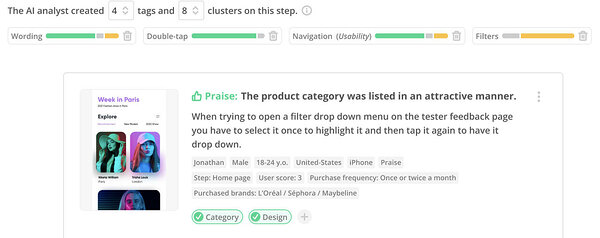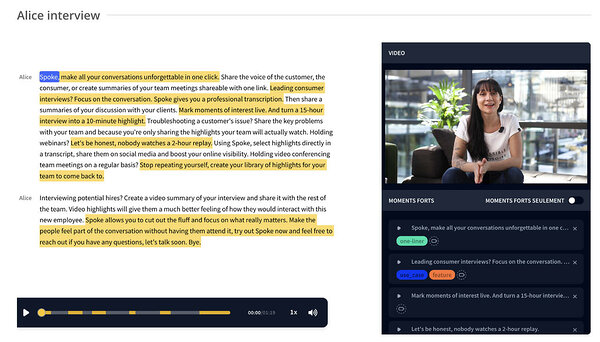June 5, 2023
Semantic analysis: a crucial phase in processing data from qualitative studies
These days, satisfaction surveys are ubiquitous. From the online store to the physical store, more and more companies want to measure the satisfaction of their customers. However, analyzing these results is not always easy, especially if one wishes to examine the feedback from a qualitative study. In this case, it is not enough to simply collect binary responses or measurement scales. This type of investigation requires understanding complex sentences, which convey nuance. The semantic analysis of qualitative studies makes it possible to do this. We explain how, in this article.
Semantic analysis, an interdisciplinary method
Originally, the method came from linguistics. However, its versatility allows it to adapt to other branches such as art, natural referencing, or marketing. It is this last discipline that interests us more particularly.
Linguistics: extracting meaning from expressions
Semantic analysis is based on the expressions used in the writings. Very close to lexical analysis (which studies words), it is, however, more complete. Its objective is to extract the meaning expressed by the sentence. It can therefore be applied to any discipline that needs to analyze writing.
Marketing: identifying customer needs
Another sector in which understanding the meaning of sentences is crucial: marketing. Indeed, the stakes are colossal. For several years, semantic analysis has been used to analyze a wide range of texts. The goal? Improve customer relations. This feedback essentially comes from three channels:
- social networks: this is social listening. This technique consists of identifying the deep feelings that a brand inspires by studying the comments.
- online surveys or opinions, on platforms or forums.
- conversations between the customer and the organization. This can be via emails, live chat, messaging or phone calls. This raw material will be transcribed for study purposes.
This approach, consisting of collecting and analyzing feedback from consumers, has a name: listening to customers. These returns include the needs, expectations and desires of the latter towards a product or service. They are also called the voice of the customer (VoC). An entire section of marketing is specialized in the collection, processing and analysis of user testimonials: UX Research.
Semantic analysis in UX Research: a formidable method
Research on the user experience (UX) consists of studying the needs and uses of a target population towards a product or service. These analyses can be conducted before or after the launch of a product. Using semantic analysis in the context of a UX study, therefore, consists in extracting the meaning of the corpus of the survey.
🔍 At Ferpection, we have long thought about the most efficient method to reveal true meaning. In particular, we wondered about the categorization. Is it more relevant to find universal labels? We thus obtain a kind of meta corpus applicable to all tests. Or, on the contrary, is it better to recreate categories for each study or group of studies? We thus gain in analysis granularity. This subject has, moreover, entitled us to a Research Tax Credit in France each year since 2016. Finally, after several tests, we opted for semantic analysis based on the second approach. To balance this, our final analyses all include the same universal grid: satisfaction, perception, and engagement. Both approaches have advantages. In any case, a limitation specific to qualitative studies is that we have a limited data set. It is then necessary to check the model for each new study (validate what has been well analyzed and correct the other categories).
Analysis based on a L'Oréal customer case. Semantic analysis makes it possible to classify the different items by category.
The benefits of semantic analysis in user research
The advantages of the technique are numerous, both for the organization that uses it and for the end user.
The benefits of the method for the company
Understanding the results of a UX study with accuracy and precision allows you to know, in detail, your customer avatar as well as their behaviors (predicted and/or proven ). This data is the starting point for any strategic plan (product, sales, marketing, etc.). Ensuring the reliability of this data is therefore a priority.
Provide personalized offers to its customers
Once this information has been collected, the various departments of the company have all the elements in hand to be able to develop relevant offers, truly adapted to their personas. Several departments of the company may be concerned:
- Research and Development (R&D): by creating products equipped with options that users really want.
- Product: by developing the products in accordance with the expectations of the target.
- Marketing: by developing a strategy allowing the product or service to meet its market (positioning, communication, services etc.)
- Commercial: by ensuring that the terms of sale (price, distribution, deadlines, etc.) are in line with the desires of buyers.
The sum of all these operations must result in a global offer making it possible to reach the product / market fit. Thus, if there is a perfect match between supply and demand, there is a good chance that the company will improve its conversion rates and increase its sales.
Detect the emergence of new trends in the market
In addition, the use of semantic analysis in UX research makes it possible to highlight a change that could occur in a market.
Take the example of organic products. Between 2000 and 2020, the market increased by 60% in France. This dramatic change did not happen overnight, however. As early as the 1980s and 1990s, studies had detected certain warning signs. Among the most representative, the desires, on the part of buyers to:
- preserve their health;
- protect the environment;
- defend animal rights.
Semantic analysis applied to consumer studies can highlight insights that could turn out to be harbingers of a profound change in a market. It is therefore essential to remain attentive to it.
The interest of the technique for the end user
Have you ever bought a product that you only use at 25% of its capacity? If so, rest assured, you are not alone. And it's a safe bet that, despite all its options, you've found one you're missing. Do you use all the programs of your dishwasher? How many times a year do you use your car's DVD player? Still, you might have wished for a device or safe with a larger capacity.
It is precisely to collect this type of feedback that semantic analysis has been adopted by UX researchers. By working on the verbatims, they can draw up several persona profiles and make personalized recommendations for each of them.
🔍 At Ferpection, we test not only your digital solutions, but also your physical products. If they are at the prototype stage, we identify areas for improvement before they are put on the market. And if they already exist (in phase of maturity or decline, for example), we test the uses that your customers make of them as well as their expectations. The individual interview, in particular, is a format that lends itself well to this type of measurement. Shall we discuss it?
Result: the consumer realizes that the company really understands their needs. They really feel considered as an individual, and no longer like an average person lost in the crowd. Their perception of the company increases. That of their user journey (consumer journey) as well. Feeling confident, they are much more inclined to make a purchase.
The 5 steps of semantic analysis in qualitative studies
As you will have understood, succeeding in understanding the meaning of the writings of your targets is a powerful weapon. But what is the methodology to follow, exactly?
1 - Data collection
Once the study has been administered, the data must be processed with a reliable system. The goal? Sort through feedback while minimizing the risk of loss and error.
Among the different techniques for collecting data from qualitative studies: the post-it method which can then be categorized properly with software.2 - Data preprocessing
In order to have a maximum of usable information, you must clean your data as meticulously as possible.
- Remove “stop words” (articles, pronouns, etc.).
- Harmonize plurals and conjugations.
- Normalize text: eliminate duplicates, remove special characters, correct spelling mistakes, etc.
3 - Semantic analysis of the corpus
We have reached the key stage. As in the field of research, your objective is to extract the “semantic juice” from your raw material. Different techniques can be used, such as:
- lexical analysis;
- syntactic analysis;
- sentiment analysis;
- named entity analysis.
Qualitative study carried out on behalf of Vinci. Semantic analysis makes it possible to bring out the uses, values and motivations of the target.
These methods make it possible to identify, in the data collected:
- the themes;
- the opinions;
- feelings;
- areas of concern;
- tendencies;
- relationships between concepts.
At this point, you've done most of the work. The data is retrieved and classified by theme. But to extract the "substantial marrow", it is still necessary to know how to analyze this dataset.
4 - Interpretation of results
This is to identify the:
- strong points;
- weak points;
- emerging trends;
- recurring problems;
- customer needs, expectations and desires.
A beginning of semantic analysis coupled with automatic transcription, here during a Proof of Concept with Spoke.
The goal is to come up with relevant insights. This step is particularly tricky because it requires knowing how to handle complex responses. Take the example of the following piece of feedback: "The website could be faster on the phone".
A simple keyword analysis would highlight the terms “internet” and “fast”. It could not take emotion into account. However, the semantic tool is also capable of perceiving this negative nuance. The same goes for the following testimonial: "Apart from the colors, the interface is superb".
Thanks to the precision of the semantic analysis, it is possible to separate the two elements: “colors” (negative emotion) and “interface” (positive feeling).
5 - Implementing an action plan
You now have all the cards in hand to plan corrective actions. These must take into account the trends identified, but also the business priorities. We also advise you to start with actions that can be solved in a fairly short time. This allows the process to begin and is motivating for the teams 😉
Improved conversion rates, better knowledge of the market… The virtues of the semantic analysis of qualitative studies are numerous. Used wisely, it makes it possible to segment customers into several targets and to understand their psychology. The study of their verbatims allows you to be connected to their needs, motivations and pain points. An invaluable resource for any marketer.
🔍 Are you seduced by the possibilities offered by semantic analysis? Would you like to know if it is possible to use it in the context of a future study? Tell us about your project! Our UX Research experts will contact you as soon as possible.
All articles from the category: User research | RSS




